digital engagement for sales cloud: 10 Powerful Success Tips 2025
Open uping Sales Success in a Digital-First World
Digital engagement for Sales Cloud is a set of tools that integrate digital messaging channels into your Salesforce environment, enabling omnichannel sales conversations with prospects and customers.
What is Digital Engagement for Sales Cloud?
– Definition: An add-on to Salesforce Sales Cloud that enables messaging through SMS, WhatsApp, Facebook Messenger, web chat, and more
– Cost: $75 per user per month (typically billed annually)
– Key Benefit: Allows sales reps to handle up to 10 conversations simultaneously, increasing productivity by up to 20%
– Core Features: Omni-Channel routing, Einstein Bots, unified conversation console, channel object linking
– Use Cases: Lead qualification, opportunity nurturing, quote discussions, order status updates
In today’s digital landscape, buyers expect immediate, convenient engagement across their preferred channels. Gone are the days when phone calls and emails were enough to drive deals forward. Modern sales teams need to meet prospects where they are—whether that’s on WhatsApp, SMS, social media, or web chat—all while maintaining a unified view of the customer journey.
Digital engagement for Sales Cloud transforms how sales teams connect with prospects by bringing all messaging channels into a single Salesforce interface, allowing for personalized, timely interactions that move deals forward faster.
I’m Samir ElKamouny AV, and I’ve helped numerous sales organizations implement digital engagement for Sales Cloud to dramatically increase their conversion rates and shorten sales cycles through strategic digital touchpoints. My approach combines technical expertise with practical sales strategies to ensure your team can maximize their digital engagement potential.
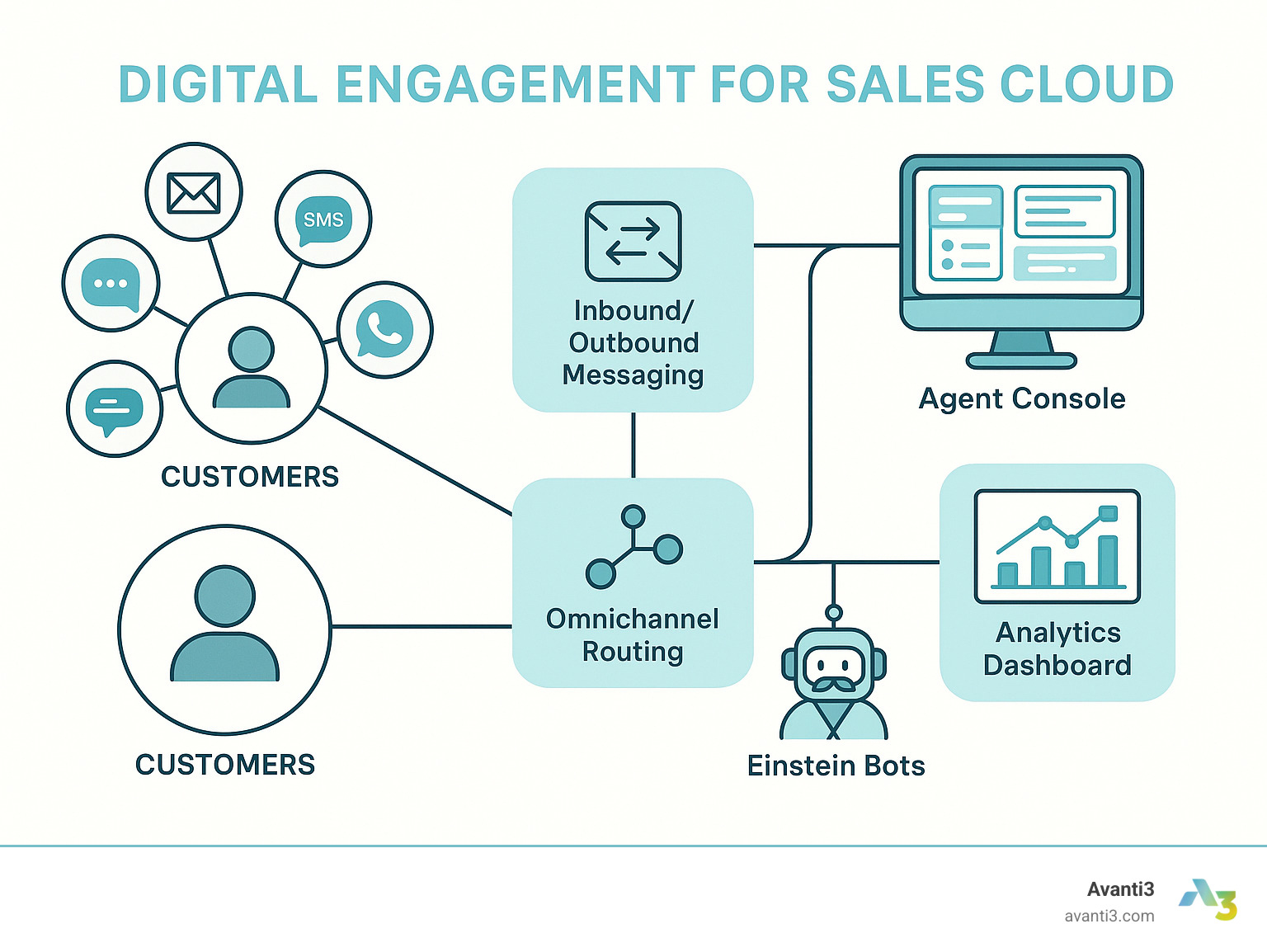
What Is Digital Engagement in Salesforce Sales Cloud?
When we talk about digital engagement for Sales Cloud, we’re referring to a powerful extension that brings all your messaging channels together in one place. It’s like having a digital command center where your sales team can have meaningful conversations with prospects and customers across any channel they prefer.
At its heart, Digital Engagement transforms how your team connects with buyers by enabling both real-time chats and pick-up-where-you-left-off conversations across multiple digital touchpoints.
What makes this tool special is how it brings everything together:
Your sales reps get a unified console where they can manage all digital conversations without switching between apps. The integration with Salesforce Customer 360 means they’ll see the complete customer story with every interaction. Plus, smart Omni-Channel routing makes sure messages reach the right person on your team, with features custom to each messaging platform’s unique needs. And perhaps best of all, conversations can flow naturally between channels while keeping all the history intact.
As Bhuwan Lodha, an SVP & Chief Digital Officer in the automotive sector, puts it: “The entire customer journey from marketing and lead nurturing to test-drive scheduling and bookings is now managed on a single platform. This makes our dealers’ jobs easier and our customers’ experiences smoother.”
| Traditional Engagement | Digital Engagement for Sales Cloud |
|---|---|
| Phone tag and voicemail | Real-time and asynchronous messaging |
| Email threads with long response times | Instant notifications and quick replies |
| Limited to business hours | 24/7 conversation capability (with bots) |
| One conversation at a time | Handle up to 10 conversations simultaneously |
| Manual record updates | Automated conversation linking to records |
| Channel-specific interactions | Seamless omnichannel experience |
| Limited contextual data | Complete customer journey visibility |
Why Digital Engagement Beats Traditional Methods
The shift to digital engagement for Sales Cloud isn’t just a tech upgrade—it’s a fundamental change in how your team connects with today’s buyers.
Think about the power of real-time messaging. Unlike email, where you might wait hours or days for a response, digital messaging lets you have those back-and-forth conversations that keep deals moving forward. When a prospect is actively considering a purchase, this immediacy can make all the difference.
There’s also the beautiful flexibility of asynchronous conversations. Unlike phone calls where both people need to be available at the same time, digital messaging lets conversations pause and resume naturally. Your prospects can respond when it’s convenient for them, and nothing gets lost in the shuffle.
From a pure efficiency standpoint, your team will love being able to handle multiple conversations at once. With the ability to manage up to 10 chats simultaneously, your cost per interaction drops dramatically compared to one-at-a-time phone calls. And because your reps can quickly share rich media (like product demos or pricing PDFs) while having all customer data at their fingertips, questions get resolved in minutes rather than days.
We saw this with a travel agency client who implemented digital engagement for Sales Cloud. Their personalized approach across digital channels boosted customer satisfaction by 23%. Travelers especially appreciated starting a conversation on the website, continuing via WhatsApp while on the go, and receiving itinerary information through SMS—all with the same sales rep who remembered every detail of their conversation.
The Role of Omni-Channel Routing
The real magic behind effective digital engagement for Sales Cloud comes from its intelligent Omni-Channel routing capabilities:
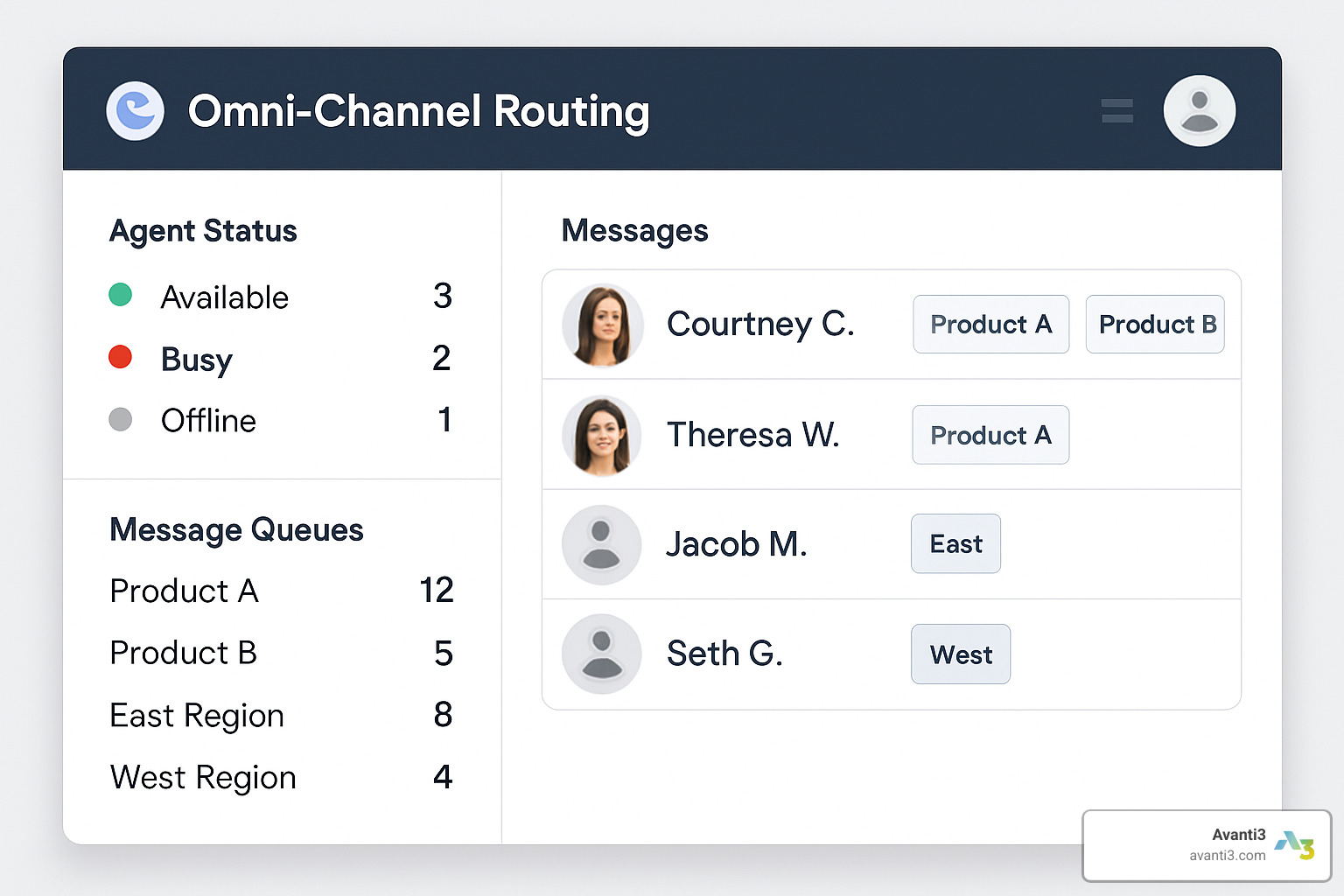
The system organizes incoming messages into queues based on whatever makes sense for your business—product lines, geographic regions, or customer segments. A financial services company might route messages from high-net-worth clients to their specialized team while sending general inquiries to another queue.
Your sales reps can set their presence status (Available, Busy, Offline) so the system knows whether to send them new conversations. This prevents any one person from getting overwhelmed and ensures customers always receive timely responses.
With skill-based assignment, messages find their way to the right expert automatically. If you’re a tech company selling multiple products, cloud infrastructure questions can go straight to your technical specialists while software licensing inquiries reach your account managers.
The system also monitors agent capacity, keeping track of how many active conversations each sales rep is handling and distributing new inquiries accordingly. This load balancing ensures your team maintains quick response times while maximizing productivity.
At Avanti3, we always recommend setting up your queues, roles, and presence statuses before adding channels. This foundational work makes everything run smoothly once you’re live with multiple messaging platforms, creating a seamless experience for both your team and your customers.
Supported Digital Channels & How They Work
Digital engagement for Sales Cloud opens up a world of possibilities for connecting with customers on their terms. Let’s explore the channels that bring your sales conversations to life – each with its own flavor and special capabilities.
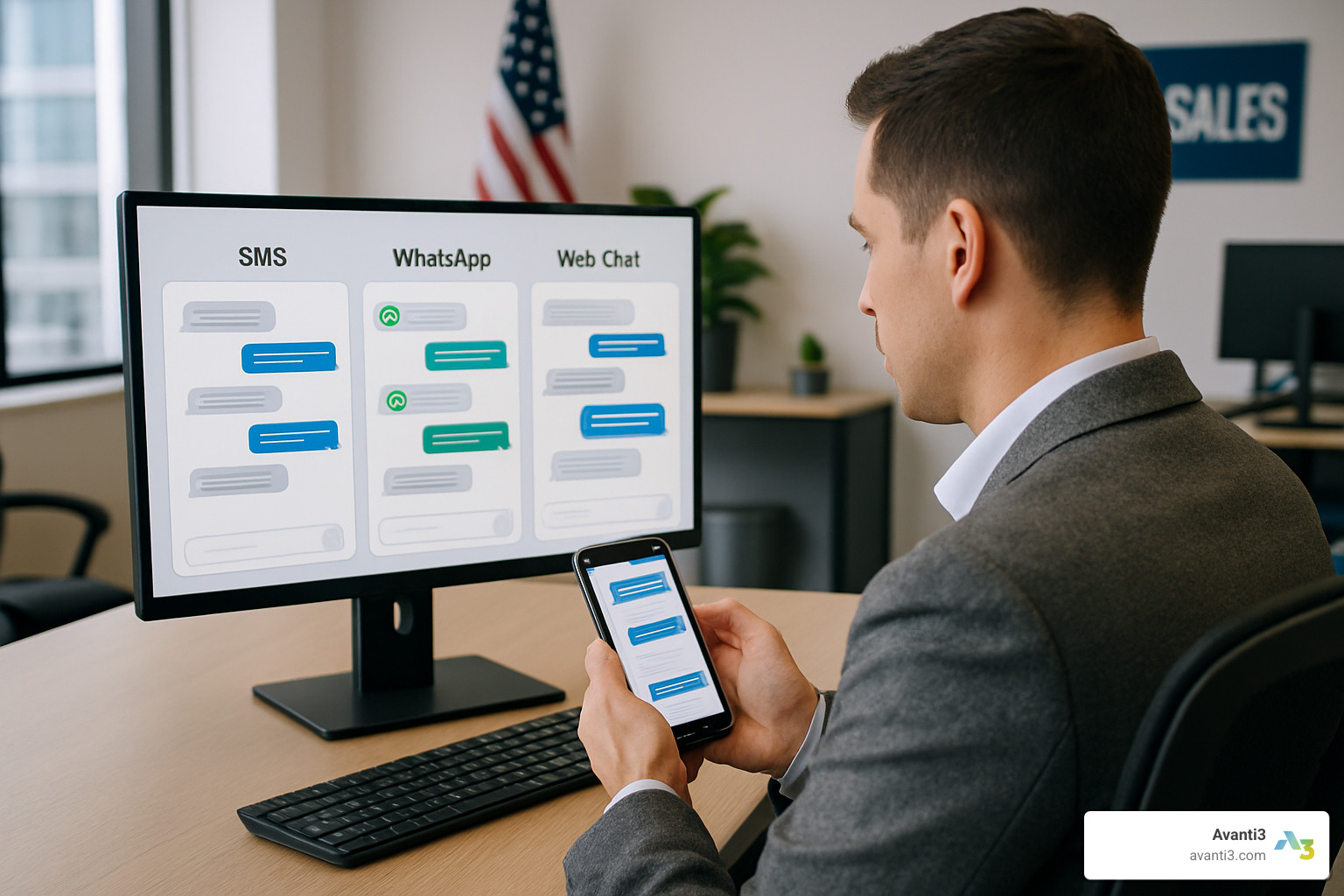
The digital landscape is evolving rapidly, with latest statistics on chatbot adoption showing that 85% of customer interactions may be handled without human agents by 2025. This shift makes understanding your channel options more important than ever.
SMS & WhatsApp Messaging
Text messaging remains one of our most intimate digital connections. When a sales message lands in someone’s personal message inbox, it carries weight and immediacy that email simply can’t match.
With SMS messaging, you’ll need to submit a Letter of Agreement with your provider to Salesforce before getting started. Once set up, the magic begins – customers can text keywords to opt in, automatically triggering responses and capturing their contact details. Your sales team can then engage in two-way conversations, all neatly routed to the right representatives.
There are some practical limits to consider – bulk messaging caps typically hover around 200-300 records per Process Builder run. But for targeted outreach, this rarely becomes a bottleneck.
WhatsApp Business takes messaging up a notch with rich media capabilities. Your sales team can share images, documents, and locations to enrich conversations. Those little “read” receipts and typing indicators? They’re surprisingly powerful for managing conversation flow and timing follow-ups.
One thing to remember with WhatsApp – you’ll need business verification and template approval. The first 24 hours after a customer reaches out is your golden window for free-form responses. After that, you’ll need to use approved templates until they engage again.
Web & In-App Chat
When prospects are actively browsing your website or using your app, there’s no better time to start a conversation. That’s where web and in-app chat shine.
Your embedded service deployments can be customized to match your brand perfectly. Place chat widgets strategically on high-intent pages and set up proactive invitations based on visitor behavior – like when someone lingers on your pricing page for more than 30 seconds.
Smart pre-chat forms gather qualification information before connecting to a sales rep, making those first moments of conversation more productive. And if your team is offline? No problem – the system can automatically create cases so no opportunity falls through the cracks.
I love seeing companies use the dynamic time selectors that let customers book appointments directly in chat. File sharing capabilities make it easy to send product specs or proposals without leaving the conversation. And when the chat ends, you can seamlessly transition to SMS or email to keep the momentum going.
One of our industrial clients found great success moving customers to a B2B portal with embedded chat. Their buyers can now purchase spare parts independently while still having immediate help available when needed – the perfect balance of efficiency and support.
Social Channels
Social media isn’t just for marketing anymore – it’s become a powerful sales channel in its own right.
Facebook Messenger integrates beautifully with your business pages, allowing for rich media conversations including carousels, quick replies, and persistent menu options. Messages route automatically to available sales reps, and you’ll see the full conversation alongside other customer interactions in your unified console.
Instagram DM integration is on the roadmap and growing in importance, especially for visually-oriented products and B2C sales. When implemented, it will help maintain brand voice consistency across platforms while integrating with your visual content marketing.
The real magic happens when these social channels connect to your CRM through digital engagement for Sales Cloud – suddenly, every conversation has context, history, and purpose.
Email & Proactive Outreach
Email remains the backbone of business communication, but digital engagement for Sales Cloud makes it smarter and more connected than ever before.
Your sales team can leverage sales cadences – structured sequences that blend email, phone, and digital messaging touchpoints. These automated follow-ups respond to prospect behavior (or lack thereof), delivering personalized content based on what’s in your CRM.
Einstein Activity Capture quietly works in the background, logging email interactions automatically and helping prioritize leads based on real engagement signals. It even suggests next best actions to move deals forward.
For longer sales cycles, nurture sequences keep prospects warm with targeted drip campaigns triggered by behavior or important dates. The handoff between marketing automation and sales engagement becomes seamless, ensuring no prospect falls through the cracks.
Channel Object Linking ties everything together, automatically connecting conversations to the relevant leads, contacts, or opportunities in your Salesforce environment. This gives your sales team the full picture every time they engage, regardless of which channel the conversation happens on.
The diverse channel ecosystem within digital engagement for Sales Cloud ensures you can meet customers wherever they prefer to communicate – creating a truly customer-centric sales experience that drives results. At Avanti3, we’ve seen how this flexible approach to engagement transforms not just conversations, but entire customer relationships.
Measuring the Impact: Benefits & ROI for Sales Teams
When sales teams accept digital engagement for Sales Cloud, they don’t just change how they communicate—they transform their entire approach to customer relationships with measurable results.
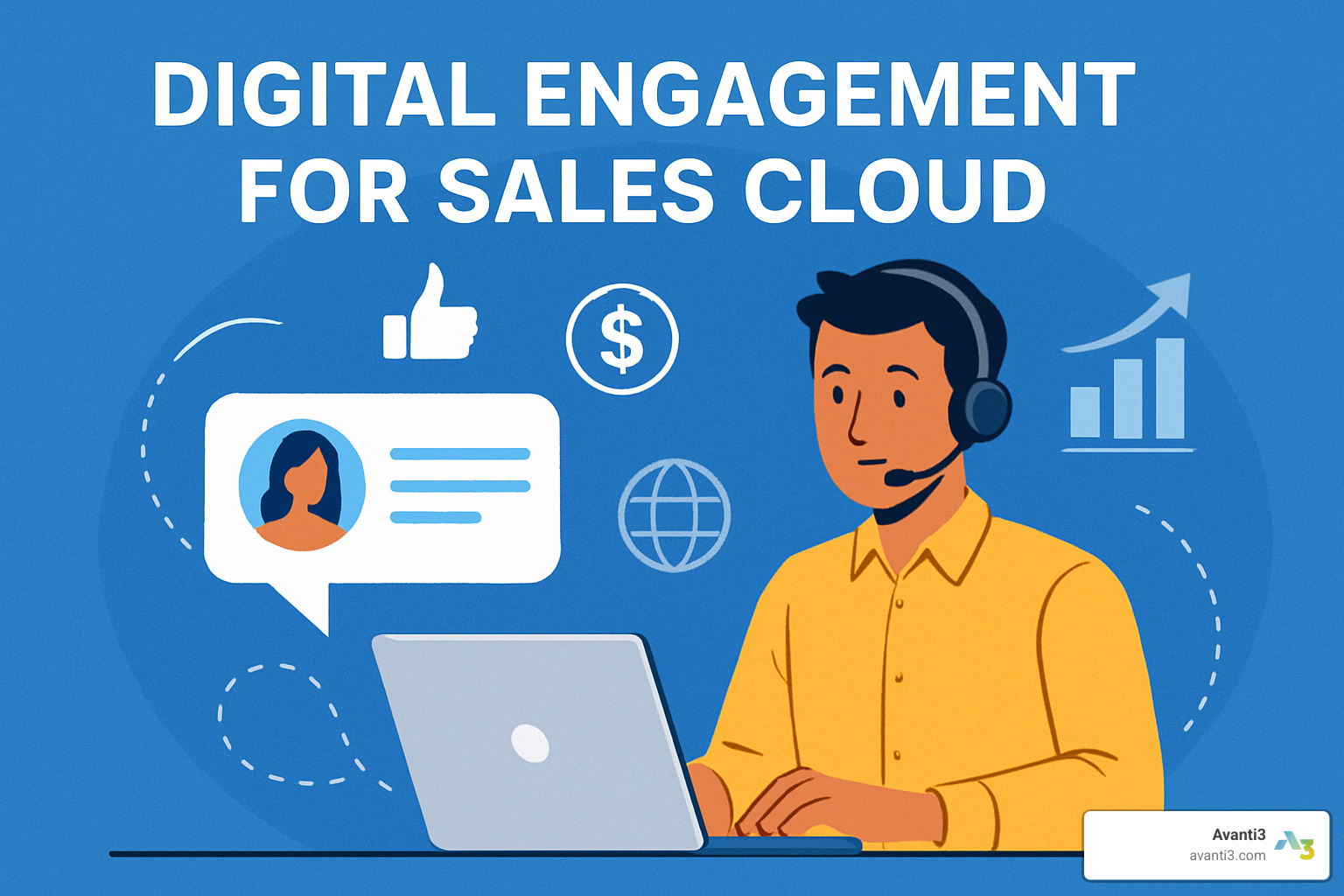
The numbers tell a compelling story. Organizations using digital engagement for Sales Cloud consistently report eye-opening improvements: case deflection reaches up to 40% through strategic chat and self-service options, sales reps can juggle up to 10 conversations at once (try doing that with phone calls!), and overall productivity jumps by about 20%. Perhaps most importantly, conversion rates climb thanks to more timely, contextual responses when prospects are actually engaged and interested.
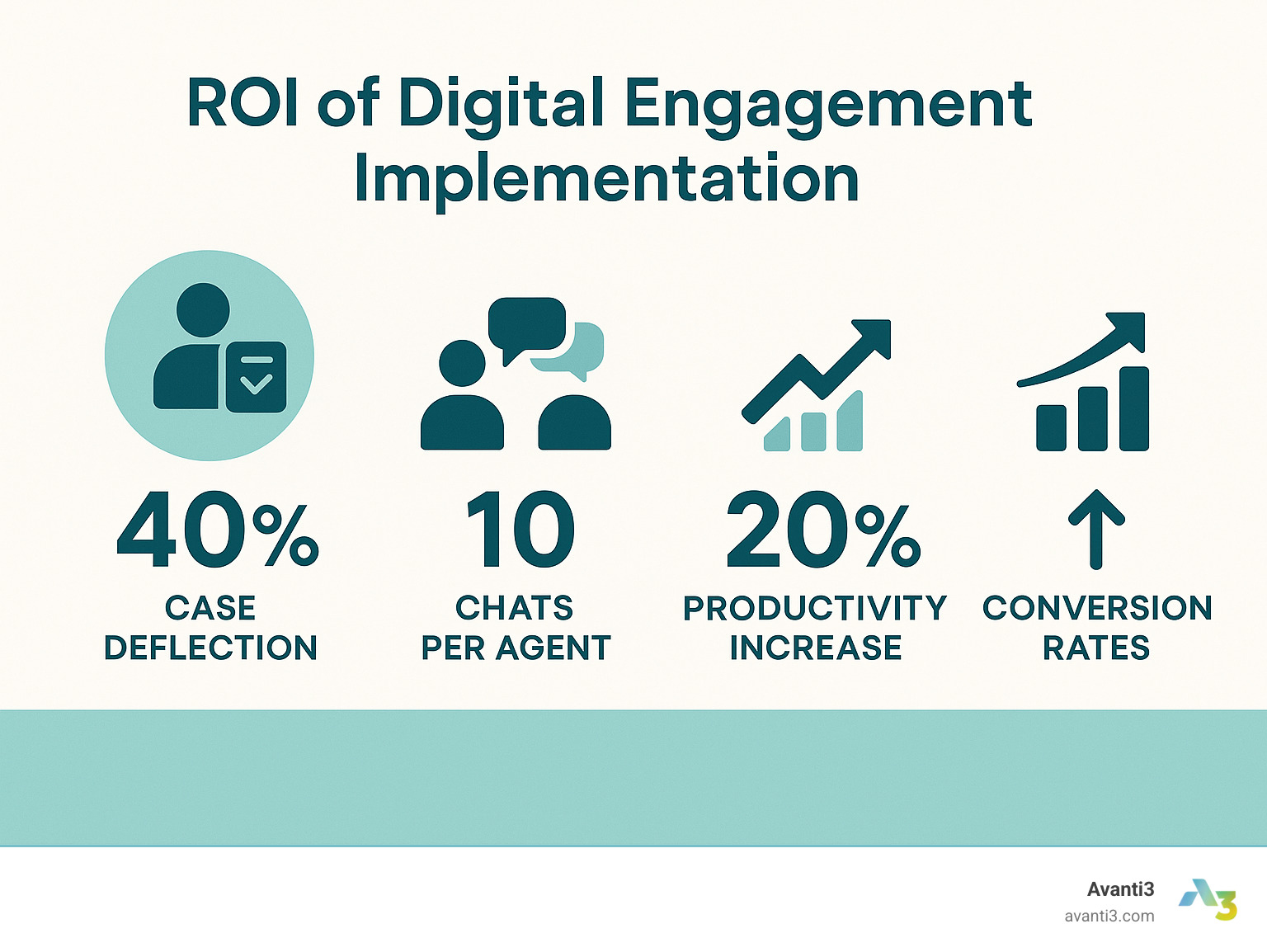
KPIs to Track Digital Engagement for Sales Cloud
To truly understand if your digital engagement strategy is working, you need to keep an eye on specific metrics that matter:
Your lead conversion rate tells the real story about digital conversations that become qualified leads. By comparing rates across channels, you’ll quickly find whether WhatsApp outperforms web chat for your particular audience, or if SMS delivers more qualified prospects than Facebook Messenger. This insight helps you double down on what’s working.
First-response time might seem like a small detail, but it makes a huge difference. Modern buyers expect quick answers—we recommend aiming for under 30 seconds on web chat and under 5 minutes for WhatsApp. When you correlate these response times with conversion success, you’ll find your sweet spot for each channel.
Watch your upsell frequency closely. Digital channels often create natural opportunities to introduce additional products or services. By tracking how often these conversations expand into larger opportunities, you’ll identify which platforms work best for cross-selling and develop targeted strategies for each.
As for ROX (Return on Experience) Metrics, they bridge the gap between warm fuzzy feelings and cold hard data. Calculate close rates by dividing closed deals by sales-qualified leads and multiplying by 100. Compare deal cycle times between digitally engaged prospects and traditional leads. These numbers help justify your investment and guide ongoing optimization.
“Experiences aren’t just about warm and fuzzy feelings. They’re also about cold hard data,” as one digital engagement expert puts it. Setting clear metrics before implementation lets you quantify impact and continuously refine your approach.
Success Metrics: Real-World Use Cases
Real organizations have achieved remarkable results with digital engagement for Sales Cloud:
A forward-thinking travel agency used digital engagement to build comprehensive customer profiles across their website, social channels, mobile app, and email. This 360-degree view enabled personalized recommendations throughout each customer’s travel journey, boosting satisfaction by 23% and increasing repeat bookings by 15%. The personalization felt natural to customers, who appreciated recommendations that actually matched their preferences.
An industrial equipment manufacturer took a different approach, creating a B2B commerce portal with embedded chat support. This clever setup allowed buyers to purchase spare parts independently while still having immediate help available when needed. The results? A 30% reduction in sales support costs alongside a 25% increase in spare parts revenue—a win-win for both the company and its customers.
In the automotive sector, one dealer network transformed their entire customer journey. As Bhuwan Lodha, their SVP & Chief Digital Officer explains: “With Salesforce, the entire customer journey from marketing and lead nurturing, to test-drive scheduling and car bookings, is now managed on a single platform. This makes our dealers’ jobs easier, and our customers’ experiences smoother.” Their metrics back up this smoothness: test drive bookings increased by 35% while lead response time dropped by 28%.
At Avanti3, we’ve helped clients achieve similar changes by pairing digital engagement for Sales Cloud with our Web3 technologies. This combination creates distinctive digital experiences that further improve customer engagement and loyalty, setting our clients apart in increasingly competitive markets.
Learn more about how digital experiences shape brand relationships through our Digital Brand Engagement resources and find how AI can further improve these connections with AI Customer Engagement strategies.
Implementing Digital Engagement for Sales Cloud
Setting up digital engagement for Sales Cloud isn’t just about flipping a switch—it’s about thoughtfully integrating these powerful tools into your sales process. Let’s walk through how to bring these digital channels to life in your Salesforce environment.

Think of implementation as building a house—you need a solid foundation before adding all the rooms. The same goes for digital engagement. We’ll start with the basics and then add the exciting features that will transform your sales team’s capabilities.
Step-by-Step Deployment Checklist
First things first—you’ll need to purchase those digital engagement for Sales Cloud licenses at $75 per user per month. It’s like buying tickets to a concert; you need them to get in the door!
Once you’ve assigned licenses to your team, it’s time to build the infrastructure. Enable Omni-Channel in Setup and create queues that will organize your incoming messages. This is where you’ll define how busy your reps can be—can they handle three conversations at once? Maybe five? Setting presence statuses like “Available” or “Busy” helps manage workflow.
Next, head to Setup > Feature Settings > Digital Engagement > Messaging Settings to turn on messaging for your organization. Think of this as opening the mailbox—you’re telling Salesforce, “Yes, we’re ready to receive messages now!”
Now comes the fun part—creating your messaging channels. Whether it’s SMS, WhatsApp, Facebook Messenger, or Web Chat, each has its own setup process. For SMS, you’ll submit a Letter of Agreement with your provider. WhatsApp requires business verification (they want to make sure you’re legit!). For Facebook Messenger, you’ll connect your business page, and for Web Chat, you’ll create those handy chat widgets for your website.
“I always recommend starting with just one or two channels,” shares a seasoned implementation specialist. “Master those before adding more. It’s like learning to juggle—start with two balls before trying five!”
The magic happens when you configure Channel Object Linking—this automatically connects conversations to your existing Salesforce records. When a customer messages you, the system can recognize them and pull up their history. No more “Who is this person again?” moments!
If you’re feeling ambitious, add Einstein Bots to handle initial greetings or simple questions. They’re like your digital receptionist, collecting basic information before handing off to your sales team. Each license includes 25 bot conversations monthly, so use them wisely!
Finally, train your team thoroughly before going live. The best technology won’t help if people don’t know how to use it. Create simple playbooks for common scenarios and be ready to coach in real-time during the initial launch.
AI & Automation in Digital Engagement for Sales Cloud
AI isn’t just a buzzword when it comes to digital engagement for Sales Cloud—it’s a practical tool that makes everything run more smoothly.
Einstein Bots come with pre-built templates for common sales scenarios like lead qualification. You don’t need to be a coding genius to set them up; the no-code bot builder lets anyone create conversation flows. These bots can tap into your knowledge base to answer frequently asked questions automatically.
25-conversation cap I mentioned earlier? Each Digital Engagement license includes this monthly allowance for Einstein Bot conversations. You can always purchase more if needed, but many teams find creative ways to maximize these conversations by using bots strategically—perhaps for initial qualification before bringing in the human touch.
The real beauty happens in the handoff. When a conversation gets complex, escalation rules ensure the customer is smoothly transferred to a sales rep with complete context. No “please repeat everything you just told the bot” moments! And if part of the conversation could still benefit from automation, reps can bring the bot back in for routine tasks.
Perhaps most exciting is the Next-Best Action AI, which uses Einstein to recommend optimal next steps in your sales process. It’s like having a seasoned sales coach whispering suggestions in your ear. “This prospect seems interested in Product X based on their questions” or “This might be a good time to mention our upcoming webinar.”
At Avanti3, we take these capabilities even further by integrating our AI Customer Engagement solutions. Our advanced machine learning delivers truly personalized interactions at scale, helping sales teams connect with prospects in meaningful ways that drive conversions.
The combination of human expertise and AI assistance creates a powerful sales approach that meets modern buyers exactly where they are—on their preferred digital channels, with the perfect balance of efficiency and personalization.
Best Practices, Compliance & Common Pitfalls
Implementing digital engagement for Sales Cloud requires attention to both technical and regulatory considerations to ensure success.
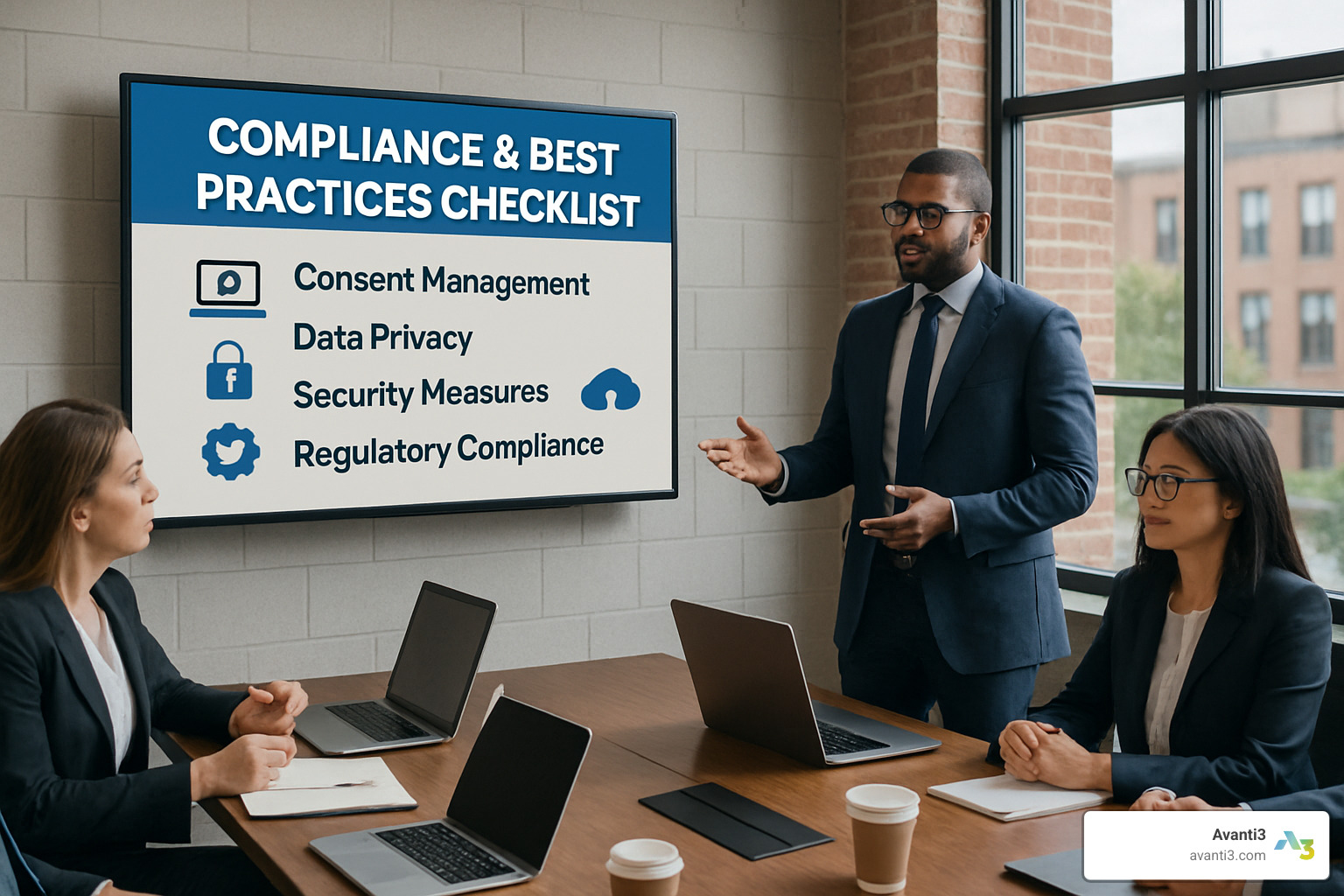
Ensuring Compliance Across Digital Channels
When it comes to digital messaging, staying on the right side of regulations isn’t just good practice—it’s essential.
Consent management forms the foundation of compliant digital engagement. Every message you send should be backed by clear, documented permission from your contact. Think of consent as a precious asset that needs careful handling. Make sure you’re implementing straightforward opt-in processes that vary appropriately by channel, whether it’s SMS, WhatsApp, or web chat.
“The biggest mistake I see companies make is treating consent as a one-time checkbox rather than an ongoing relationship,” says a digital compliance expert I work with regularly. Always provide simple, obvious ways for contacts to opt out of future communications, and honor these requests immediately.
GDPR and data privacy considerations can’t be overlooked in today’s regulatory environment. Your digital engagement strategy needs to include transparent policies about data collection, usage, and retention. Be upfront with customers about how their conversation data will be used, and create a straightforward process for data deletion requests when required by law.
Maintaining a complete audit trail of all digital interactions isn’t just about compliance—it’s about building trust. Document consent timestamps and methods, regularly review your messaging policies, and implement supervisor monitoring to ensure quality conversations across your team.
“Unfortunately, Digital Engagement is not included in the standard Service Cloud license,” notes a Salesforce expert. This licensing consideration is important when planning your implementation budget and ensuring compliance with your license agreements.
Overcoming Limitations & Scaling
Every powerful tool has its limitations, and digital engagement for Sales Cloud is no exception. The good news? With some creative thinking, these limitations become manageable challenges rather than roadblocks.
Bulk messaging caps can feel restrictive when you’re eager to reach your entire audience. Standard Digital Engagement limits you to about 200-300 records per Process Builder run. I’ve helped clients overcome this by segmenting their audiences into smaller, more targeted batches—which often improves engagement rates anyway. For truly large-scale campaigns, consider integrating with Marketing Cloud or exploring specialized third-party messaging solutions.
The constraints around proactive outreach vary by channel. WhatsApp requires pre-approved templates for business-initiated messages. SMS demands prior opt-in before sending marketing content. Web chat only works with visitors already on your digital properties. Rather than seeing these as limitations, view them as guardrails that protect the customer experience and your brand reputation.
Keeping costs under control requires thoughtful planning. Cost control strategies should include monitoring your Einstein Bot conversation usage (each Digital Engagement license includes just 25 bot conversations monthly), implementing tiered support models, and regularly reviewing channel performance to focus your investment where it delivers the highest return.
At Avanti3, we help clients extend beyond these limitations by implementing complementary engagement solutions that work seamlessly with digital engagement for Sales Cloud, creating richer experiences while maintaining that all-important single view of the customer.
Best-Practice Playbook: Digital Engagement for Sales Cloud Reps
The difference between teams that merely use digital engagement tools and those that truly excel with them often comes down to execution. Here’s how to help your sales reps shine in digital conversations:
Build a library of personalized snippets that reps can quickly customize for common scenarios. These pre-approved message templates should pull dynamic data from your CRM to personalize each interaction. Make sure to create variants optimized for each platform’s format—what works in SMS might feel awkward in WhatsApp or Facebook Messenger.
Design thoughtful sales cadences that blend multiple channels for different buyer personas. The most effective sequences combine automated touchpoints with strategic manual intervention. A financial services client of mine saw a 34% increase in appointment bookings after implementing a cadence that started with web chat, followed up via WhatsApp, and included personalized video messages at critical decision points.
“Embedding revenue milestones and personalized guidance in the flow of work keeps sellers engaged and on track,” explains a sales enablement expert I collaborate with. Regular dashboard reviews should become part of your team’s rhythm. These check-ins help identify which channels are performing best for different segments and which conversation patterns lead to successful outcomes.
Create coaching loops that celebrate and replicate winning approaches. When a rep has a particularly successful digital conversation that converts a prospect or advances an opportunity, share that conversation (appropriately anonymized) as a learning opportunity. The best sales leaders I work with create playlists of exemplary conversations that new team members can study.
By combining these practices with the powerful capabilities of digital engagement for Sales Cloud, your sales team can create meaningful connections that move deals forward faster while building stronger customer relationships. The digital channels may be new, but the fundamentals of good sales conversations remain timeless.
Pricing, Licensing & Integration Considerations
Let’s talk money – because at the end of the day, understanding what digital engagement for Sales Cloud will cost your business is crucial for making smart decisions.
When I work with clients on implementing digital engagement solutions, the first question is almost always about cost. Here’s the straightforward breakdown:
The core digital engagement for Sales Cloud license runs $75 per user per month when billed annually. This isn’t just another expense – it’s an investment that enables your team to handle multiple conversations simultaneously across all those channels your customers actually use.
Each license includes some pretty valuable entitlements:
– Unlimited inbound messaging across all supported channels
– 25 Einstein Bot conversations per user each month (which can handle a surprising amount of initial qualification)
– 1,000 outbound messages for your entire organization
“Digital Engagement can be added to selected Service Cloud editions at a set price of $75/user/month,” confirms a Salesforce pricing specialist I recently consulted. That said, if you have Service Cloud Unlimited Edition, you might already have some of these features included – definitely worth checking before you purchase additional licenses!
Beyond the Basics: Additional Costs
As your digital engagement strategy matures, you might need to expand beyond those initial entitlements. This is where the additional costs come in:
If your Einstein Bots become popular (a good problem to have!), you’ll need to purchase additional bot conversations. The same goes for WhatsApp Business API, which might require separate credits as your message volume grows.
SMS costs vary by provider and volume – something to keep in mind if you’re planning large-scale text message campaigns. And if you need more than the two included social accounts, you’ll likely need extra licensing there as well.
I always recommend clients start with a conservative approach and scale up as they see ROI from their initial implementation.
Making It All Work Together: Integration Considerations
Digital engagement for Sales Cloud becomes even more powerful when it’s properly integrated with your broader technology ecosystem. Here’s what to consider:
MuleSoft Connectors provide the bridge between your digital engagement tools and external systems. For example, you might want to pull inventory data from your ERP system directly into sales conversations.
Marketing Cloud Sync ensures your sales engagement efforts align perfectly with broader marketing campaigns. This coordination prevents the awkward situation where marketing sends one message while sales is having a completely different conversation.
Experience Cloud extends your digital engagement capabilities to partner communities, creating a unified experience for your entire ecosystem.
Custom API Integrations might be necessary for specialized business requirements that go beyond standard capabilities.
At Avanti3, we specialize in extending digital engagement for Sales Cloud with our Web3 technologies. Our solutions integrate seamlessly with Sales Cloud while adding unique digital experiences, rewards systems, and community-building opportunities that take customer engagement to the next level.
The beauty of Salesforce’s platform is its flexibility – with the right integration strategy, you can create a truly unified experience across all your customer touchpoints. Just remember that these integrations may require additional expertise or partner support to implement correctly.
When planning your budget, be sure to consider not just the core licensing costs but also these potential integration needs to get the full picture of your investment.
Frequently Asked Questions about Digital Engagement for Sales Cloud
If you’re considering digital engagement for Sales Cloud for your business, you probably have some questions. Let’s address the most common ones we hear from our clients at Avanti3.
How quickly can we launch digital engagement for Sales Cloud?
The million-dollar question! While everyone wants digital channels yesterday, a thoughtful implementation sets you up for success.
Most basic implementations take 2-4 weeks to get up and running with core channels and routing. This timeline works well if you’re focusing on just one or two channels like web chat and SMS.
For intermediate implementations that include Einstein Bots and custom conversation flows, plan for 4-8 weeks. The extra time allows for proper bot training and testing to ensure your automated conversations actually help rather than frustrate customers.
More complex deployments with multiple channels, extensive integrations, and advanced automation typically require 8-12 weeks from start to finish.
What impacts your timeline most? The number of channels you’re implementing, how complex your integration needs are, how sophisticated your bot scenarios need to be, and how much change management your team requires.
At Avanti3, we’ve found that a phased approach works best – start with one high-impact channel, get it working smoothly, and then expand. This approach builds confidence, secures early wins, and gives your team time to adapt to new workflows.
What channels are included out of the box?
Digital engagement for Sales Cloud supports a robust array of messaging channels that connect seamlessly with your Salesforce environment:
Web Chat is the most straightforward to implement, embedding directly on your website or in your mobile app. It’s perfect for engaging visitors while they’re actively exploring your products.
SMS messaging provides direct access to your prospects’ phones but requires setting up an SMS provider and submitting a Letter of Agreement to Salesforce.
WhatsApp Business messaging offers rich features like read receipts and media sharing but requires going through the WhatsApp Business API verification process.
Facebook Messenger connects directly to your business page, allowing you to manage social conversations without leaving Salesforce.
In-App Messaging lets you embed conversations directly into your mobile applications for a seamless experience.
Social Media accounts (typically two, such as Facebook and Twitter) come with Service Cloud and integrate with the same unified console.
While all these channels are supported, each requires specific configuration steps. The beauty is that once set up, your sales team manages all conversations through a single interface.
How do we measure ROI after go-live?
Measuring return on investment for your digital engagement for Sales Cloud implementation should balance both efficiency gains and revenue impact.
On the efficiency side, track how quickly your team responds to inquiries (this should improve dramatically), how many conversations each rep can handle simultaneously (up to 10 is possible), and the reduction in time spent on manual data entry.
For revenue metrics, focus on conversion rates through digital channels compared to traditional methods, sales cycle length (which typically shortens with digital engagement), and increases in upsell opportunities identified through conversations.
One simple but powerful calculation is your close rate: divide closed deals by sales-qualified leads and multiply by 100. Track this before implementation and at regular intervals after to quantify your improvement.
I recommend establishing baseline metrics before launch, then checking in at 30, 60, and 90 days post-implementation. This cadence gives you meaningful data points while allowing time to optimize your approach based on what you’re learning.
The most successful implementations we’ve seen at Avanti3 combine these quantitative metrics with qualitative feedback from both sales reps and customers. When both groups report more satisfying interactions, you know you’re on the right track.
While the technology is powerful, it’s the human touch that makes digital engagement truly effective. The best results come when your team accepts these tools as ways to be more personal and responsive, not just more efficient.
Conclusion
Digital engagement for Sales Cloud represents a fundamental shift in how sales teams connect with prospects and customers in today’s digital-first world. By bringing together multiple messaging channels into a unified Salesforce experience, organizations can meet buyers where they are while maintaining complete context and continuity throughout the customer journey.
The benefits are clear:
– Increased sales productivity with reps handling up to 10 conversations simultaneously
– Improved customer experience through faster, more convenient engagement
– Improved visibility into the complete customer journey across all touchpoints
– Accelerated sales cycles through real-time digital interaction
As we’ve seen from real-world examples across industries, from travel agencies to industrial equipment manufacturers to automotive dealers, digital engagement for Sales Cloud delivers measurable improvements in both efficiency metrics and revenue outcomes.
At Avanti3, we believe that digital engagement is just the beginning. By combining Salesforce’s powerful engagement capabilities with our innovative Web3 technologies, we’re helping organizations create truly unique digital experiences that not only facilitate sales conversations but build lasting customer relationships and communities.
The future of sales engagement will continue to evolve, with AI playing an increasingly important role in personalizing interactions at scale. Organizations that accept these technologies today will be well-positioned to meet changing customer expectations and gain competitive advantage in their markets.
Ready to transform your sales engagement strategy? Explore our Digital Engagement Solutions to learn how Avanti3 can help you maximize the potential of digital engagement for Sales Cloud with our unique approach to customer connection.







